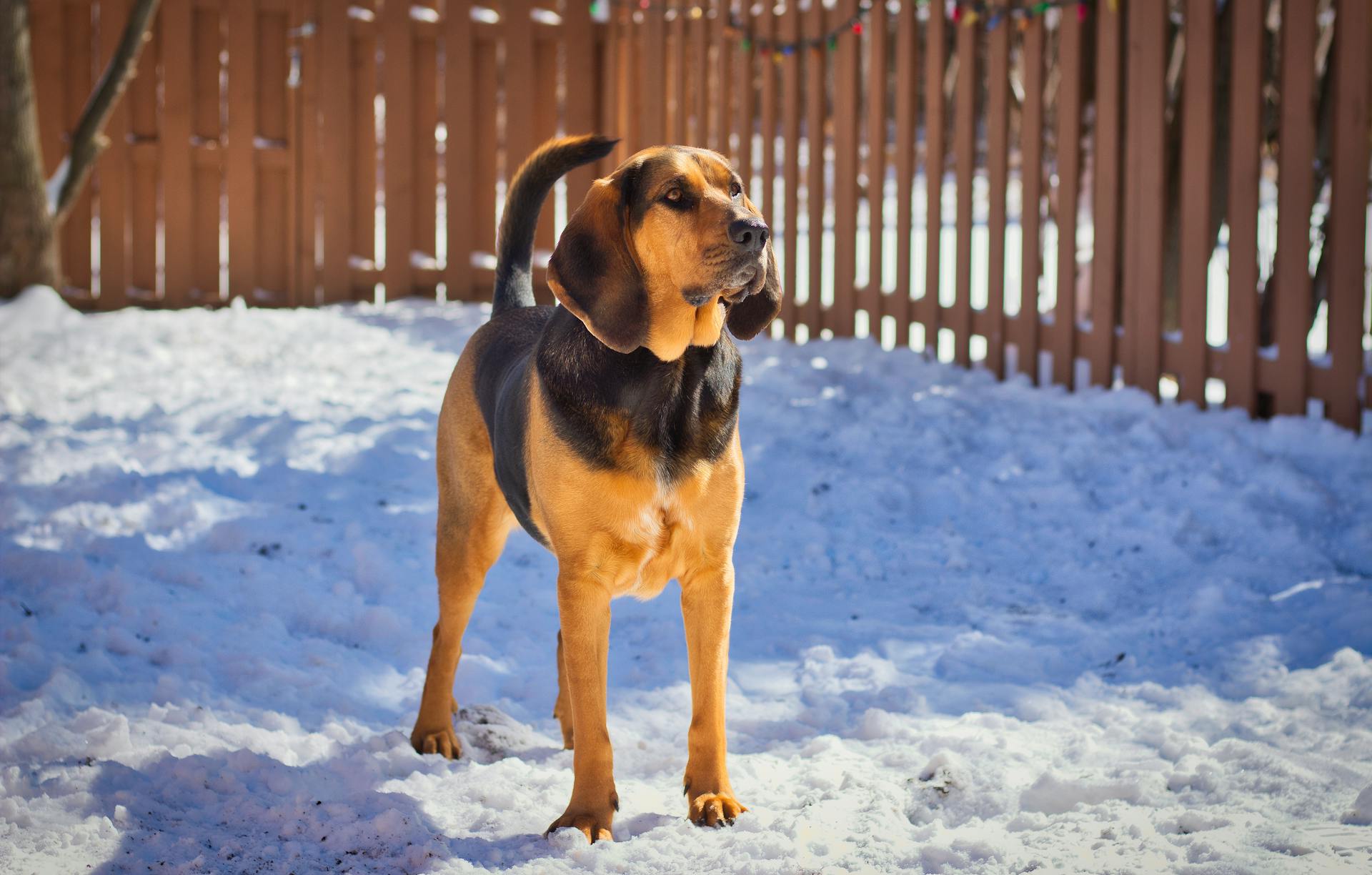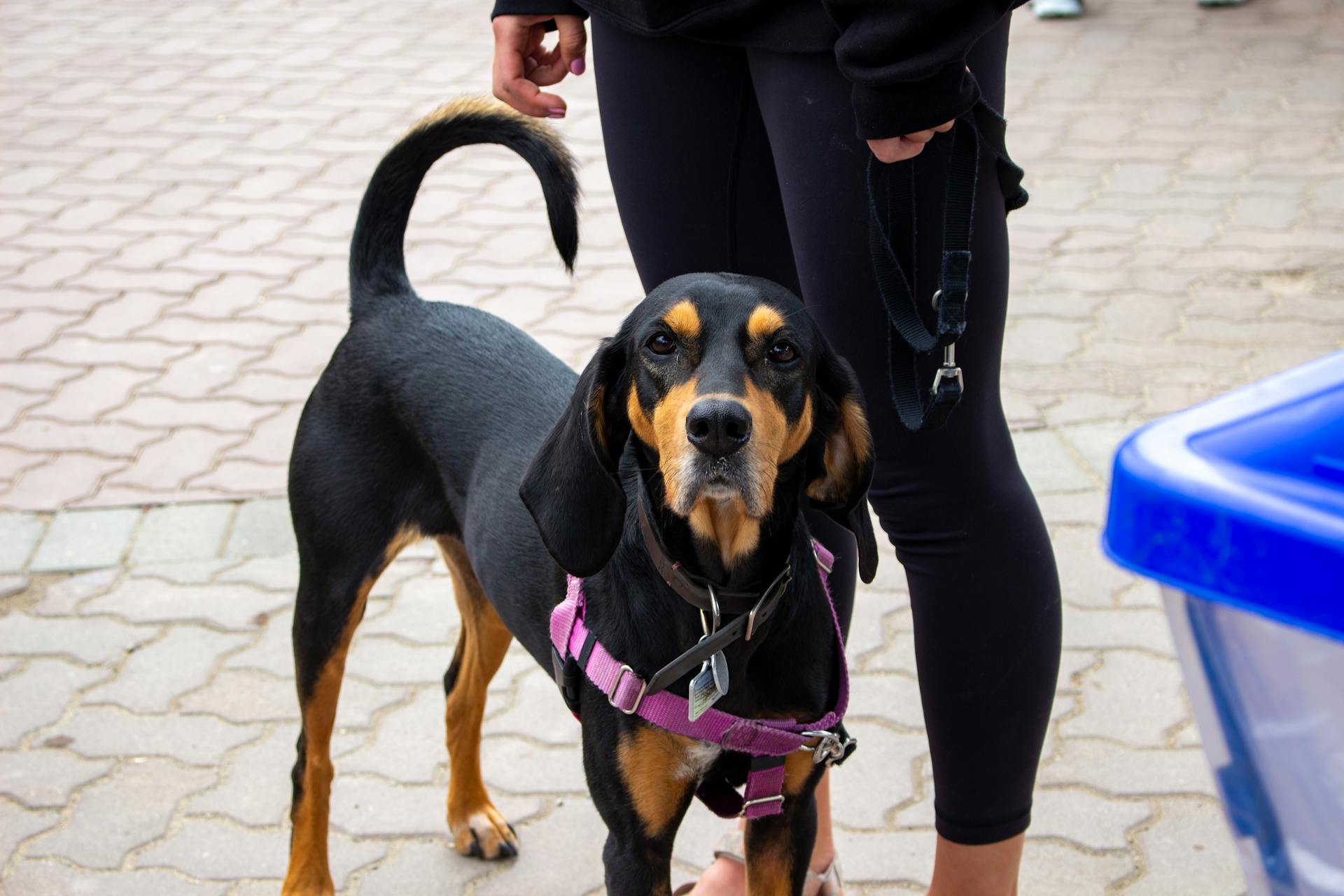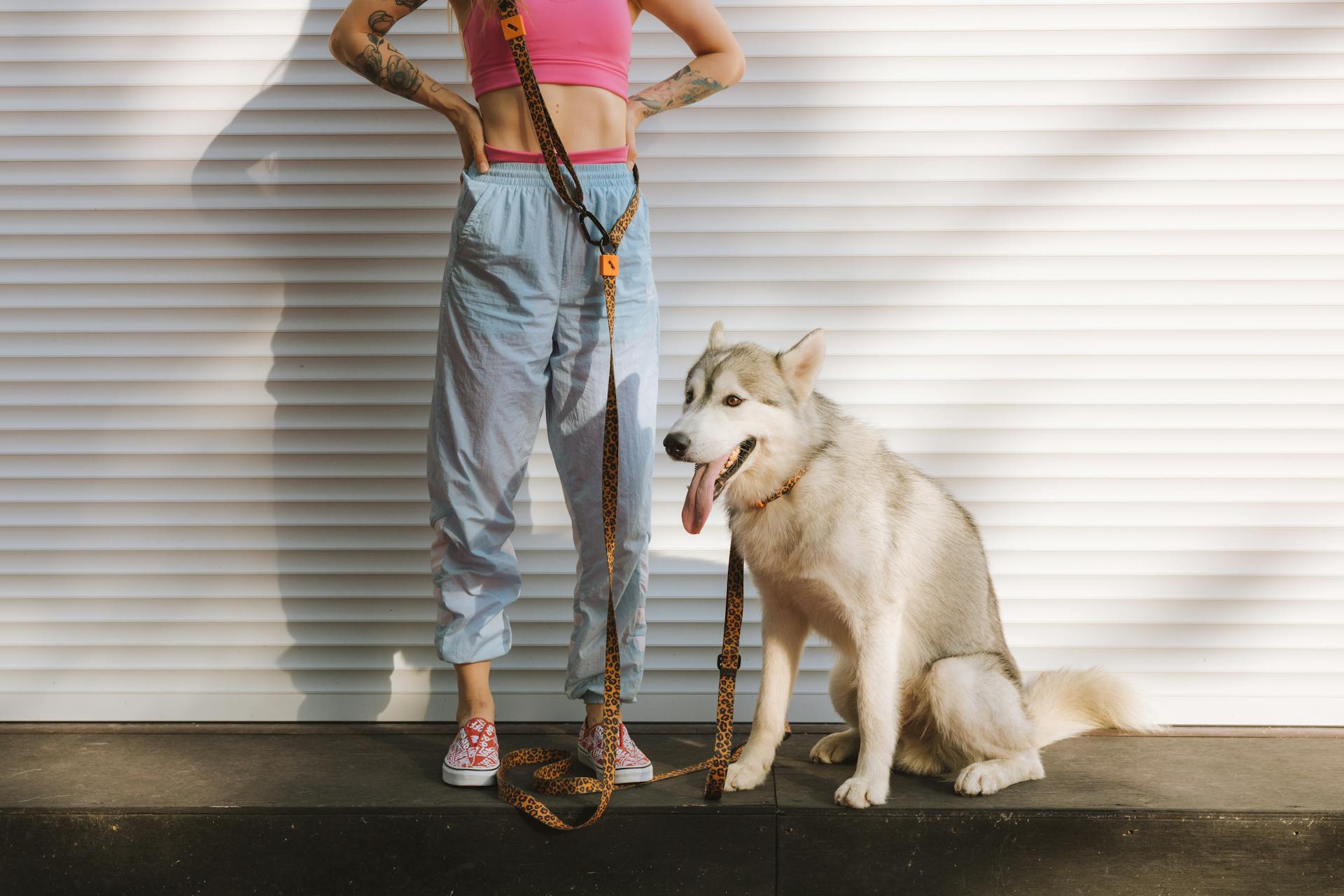
Bloodhounds are prone to a few health issues that you should be aware of as a responsible owner. Hip dysplasia is a common problem in Bloodhounds, which can lead to arthritis and mobility issues.
Their large size and deep chest can also cause breathing difficulties, especially during exercise or in hot weather. This is because their trachea can become compressed, making it harder to breathe.
Bloodhounds are also at risk for eye problems, including entropion and ectropion, which can cause discomfort and vision issues. These conditions can be painful and require surgical correction if left untreated.
Regular check-ups with a veterinarian can help identify potential issues early on, allowing for prompt treatment and prevention of more serious problems.
Common Health Issues
Bloodhounds are generally healthy dogs, but like all breeds, they can be prone to certain health issues. A common concern is periodontal disease, which can be prevented by brushing your dog's teeth daily.
Gastric Dilatation and Volvulus, also known as bloat, is another issue that can affect Bloodhounds. It's a serious condition that requires immediate veterinary attention.
Other potential health issues include hip dysplasia, elbow dysplasia, and cherry eye. Hip dysplasia is a genetic condition that affects the hip joint, while elbow dysplasia affects the elbow joint. Both conditions can cause arthritis and pain in the affected joints. Cherry eye is a condition where the third eyelid gland becomes inflamed and protrudes from the eye.
Here are some common signs of potential health issues in Bloodhounds:
- Change in appetite or water consumption
- Tartar build-up, bad breath, red gums, or broken teeth
- Itchy skin (scratching, chewing or licking), hair loss
- Lethargy, mental dullness, or excessive sleeping
- Fearfulness, aggression, or other behavioral changes
Bloodhounds are also susceptible to bacterial and viral infections, such as parvo, rabies, and distemper. These infections can be prevented through vaccination, which should be recommended by your veterinarian based on the diseases present in your area and your dog's age and other factors.
Take a look at this: Ear Infections in Goldendoodles
Hip and Elbow Dysplasia
Hip and Elbow Dysplasia is a serious issue that affects many Bloodhounds. It's an inherited disease that causes the joints to develop improperly, resulting in arthritis.
Bloodhounds are particularly prone to this condition, and it's essential to be aware of the signs and symptoms. Stiffness in the elbows or hips may become a problem as your dog matures.
You may notice that your Bloodhound begins to show lameness in his legs or has difficulty getting up from lying down. This is a clear indication that something is wrong.
Overweight dogs may develop arthritis years earlier than those of normal weight, causing undue pain and suffering. This is a harsh reality that many pet owners face.
Elbow dysplasia and hip dysplasia are conditions where the bones of the elbow or hip joints do not align appropriately. This causes the bones to rub and grind, resulting in deterioration of the joint and loss of function.
The good news is that these conditions can be screened for with x-rays. However, treatment will vary depending on the severity of the condition.
Responsible breeders should screen for health conditions that commonly affect the breed, including hip and elbow dysplasia. This is crucial in preventing the spread of the disease.
What to Watch For
As a Bloodhound owner, it's essential to be aware of the potential health issues that can affect your furry friend. By knowing what to watch for, you can catch any problems early on and prevent them from becoming serious.
Bloodhounds are prone to periodontal disease, which can be prevented by brushing their teeth daily. This simple habit can save you and your dog a lot of trouble in the long run.
Changes in appetite or water consumption are common signs of underlying health issues. If you notice your Bloodhound eating less or more than usual, or drinking more water than usual, it's a good idea to take them to the vet.
Tartar build-up, bad breath, red gums, or broken teeth are all signs of periodontal disease. Brushing your dog's teeth daily can help prevent these issues.
Itchy skin, hair loss, lethargy, mental dullness, or excessive sleeping can all be signs of underlying health issues. If you notice any of these symptoms in your Bloodhound, it's a good idea to take them to the vet.
Consider reading: Is Walking Good for Dogs with Arthritis
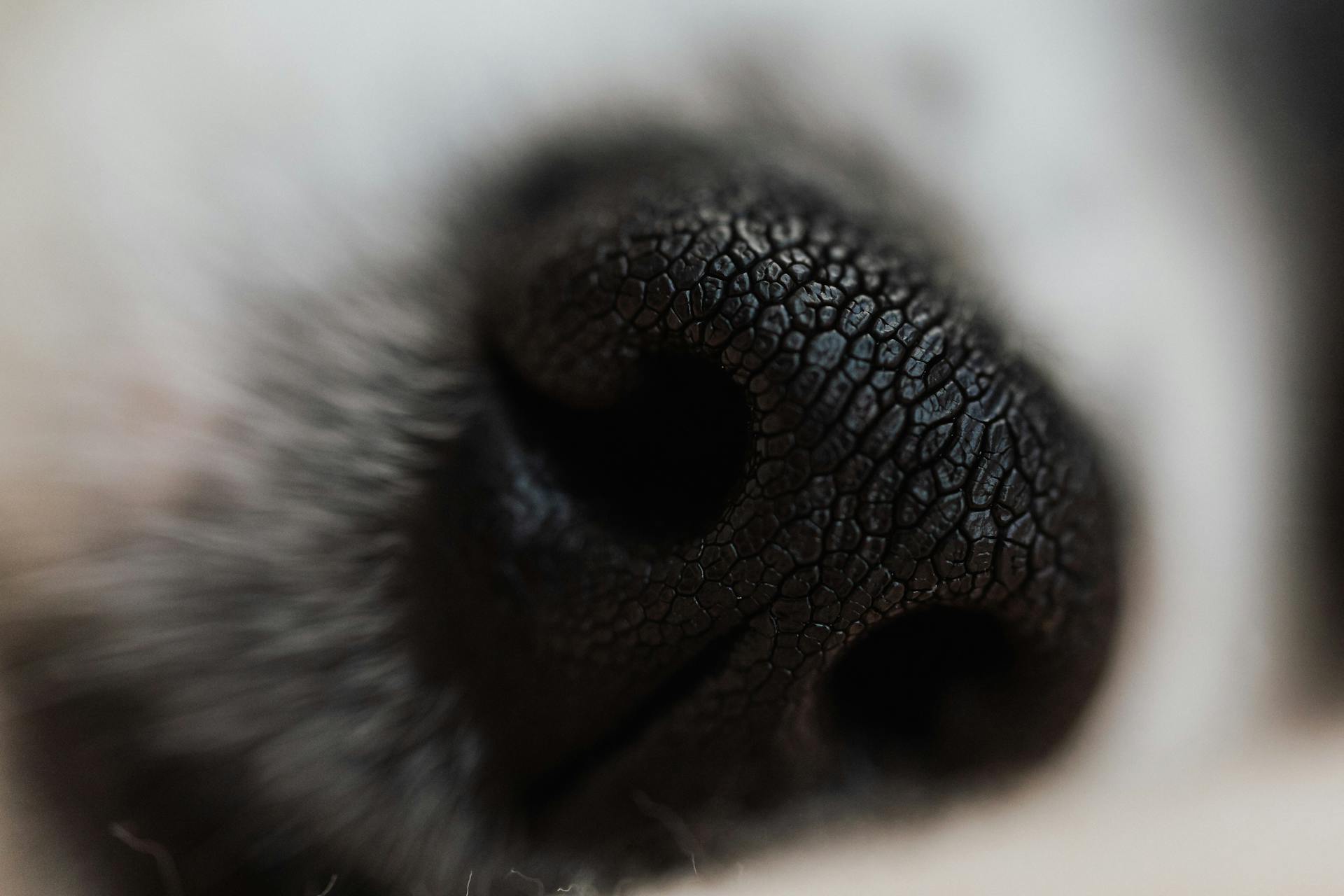
Bloodhounds are also susceptible to bacterial and viral infections, such as parvo, rabies, and distemper. These infections are often preventable through vaccination, which your vet will recommend based on the diseases in your area and your dog's age.
Here are some common signs that your Bloodhound needs veterinary attention:
- Change in appetite or water consumption
- Tartar build-up, bad breath, red gums, or broken teeth
- Itchy skin (scratching, chewing or licking), hair loss
- Lethargy, mental dullness, or excessive sleeping
- Fearfulness, aggression, or other behavioral changes
Remember, it's always better to err on the side of caution when it comes to your dog's health. If you're ever in doubt, it's always best to consult with your vet.
Eye and Ear Care
Bloodhounds are prone to eye problems, including dry eye, which can cause sore, itchy eyes and infections. This painful condition can be treated with ointment, but it requires lifelong application.
Dogs have a third eyelid that contains a gland that produces about one-third of the fluid that bathes the eye. If the gland is sore or swollen, it looks like a red blob in the corner of the eye, a condition called cherry eye.
Entropion is a condition where the eyelid rolls inward, causing the eyelashes to rub against the cornea, which can ultimately lead to blindness. This heritable disorder is especially common in Bloodhounds.
Bloodhounds are also prone to ear infections due to their floppy ears, which can trap moisture and allow bacteria and yeast to thrive. Regular ear cleaning with a veterinary-approved ear cleanser can help prevent these infections.
Their long, droopy ears require regular cleaning, especially after a bath or a swim, to keep their ear canals healthy.
Eye
Dry eye, also known as keratoconjunctivitis sicca or KCS, is a common condition in Bloodhounds. It's caused by tear glands not producing enough tears to keep the eye moist.
Symptoms of dry eye include a thick discharge, squinting, pawing at the eye, or a dull, dry appearance of the eye. This is a painful condition that requires immediate attention.
Cherry eye is another condition that can occur in Bloodhounds. It's caused by a sore or swollen gland in the third eyelid, which produces fluid that bathes the eye.
Cherry eye can occur suddenly in one or both eyes, and it's more common in puppies or young Bloodhounds. If you notice a red blob in the corner of your dog's eye, it could be a sign of cherry eye.
Entropion is a condition where the eyelid rolls inward, causing the eyelashes to rub against the cornea. This is an extremely irritating and painful condition that can ultimately lead to blindness.
Cataracts are a common cause of blindness in older Bloodhounds. They occur when the lenses of the eyes become more opaque, or cloudy, over time.
A different take: Canine Diabetes and Blindness
Ear
Ear infections are a common issue for Bloodhounds due to their floppy ears. Regular ear cleaning can help prevent these infections.
You should clean your Bloodhound's ears weekly, even as a puppy, to keep them healthy. This is especially important after a bath or swim, as moisture can become trapped in the ear canals.
A veterinary-approved ear cleanser is the best choice for cleaning your Bloodhound's ears. Be sure to follow the instructions provided with the cleanser.
Discover more: Bloodhound Dog Names
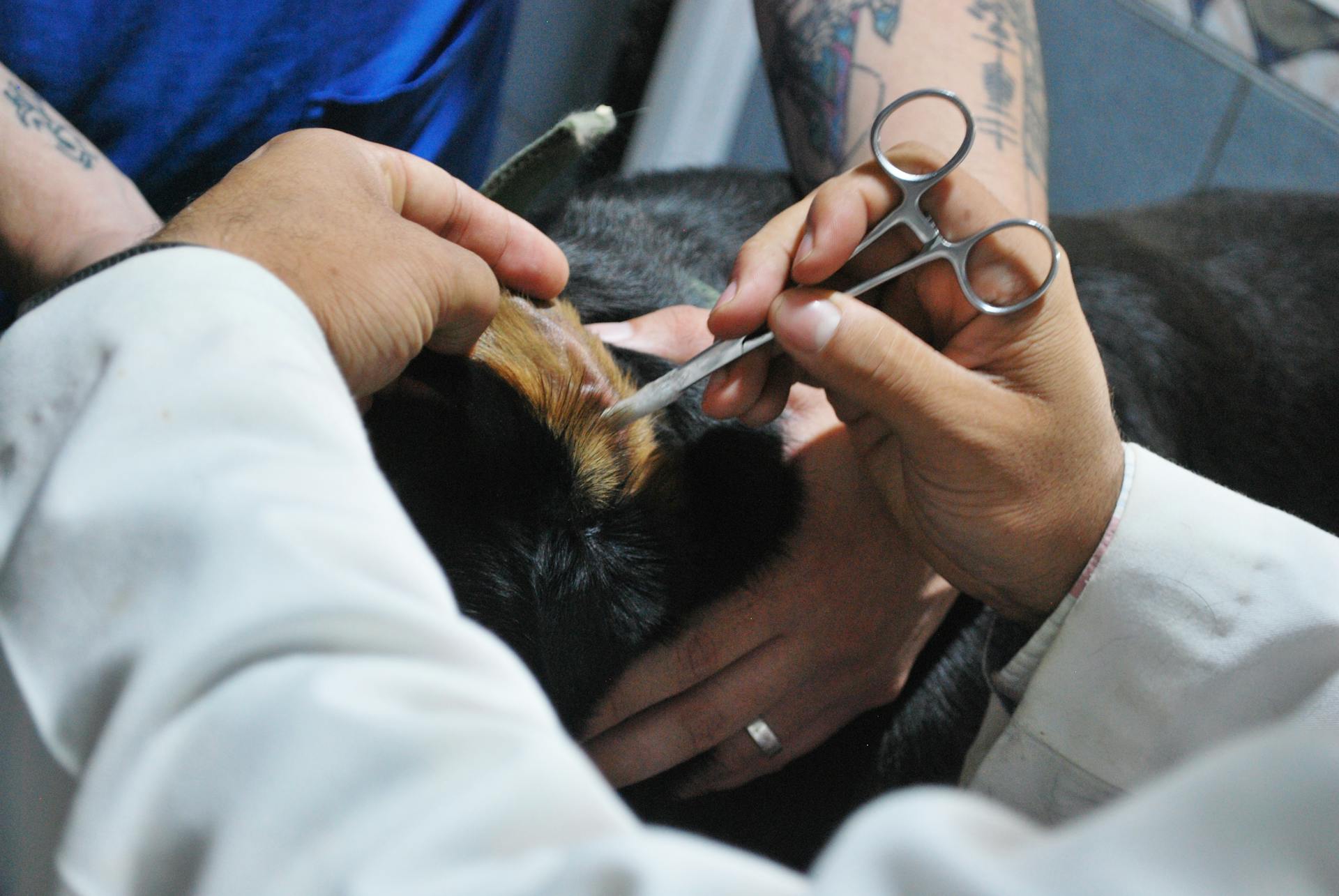
Here are some ear care tips for your Bloodhound:
- Clean your Bloodhound's ears weekly, even as a puppy.
- Use a veterinary-approved ear cleanser.
- Follow the instructions provided with the cleanser.
- Clean your Bloodhound's ears after a bath or swim.
Bloodhounds are prone to ear infections because moisture can easily become trapped in the ear canals, allowing bacteria and yeast to thrive.
Dental and Skin Care
Dental disease is the most common chronic problem in pets, affecting 80% of all dogs by age two. Your Bloodhound is more likely than other dogs to have problems with her teeth, which can lead to infection of the gums and roots of the teeth.
Tartar build-up on the teeth is the first sign of dental disease, and it can progress to infection if left untreated. Regular teeth cleaning is crucial to prevent dental disease, and you can also brush your Bloodhound's teeth at home at least twice a week to keep them perfect.
Bloodhounds are generally prone to skin infections, including Malassezia dermatitis, which causes itching, redness, and brown waxy discharge in the ears. Regular ear cleaning can help prevent this infection, and you should clean your Bloodhound's ears weekly, even as a puppy.
Additional reading: Canine Distemper Teeth
Here are some key tips for dental and skin care:
- Clean your Bloodhound's teeth regularly and brush them at least twice a week.
- Clean your Bloodhound's ears weekly, especially if you notice any signs of infection.
- Keep your Bloodhound's diet consistent and avoid giving them people food.
- Regularly check your Bloodhound's facial wrinkles and eyes for any signs of debris or infection.
Dental
Dental care is crucial for your Bloodhound's overall health.
Dental disease is the most common chronic problem in pets, affecting 80% of all dogs by age two.
Regular brushing is key to preventing dental disease. Brush your Bloodhound's teeth at least twice a week to keep them perfect.
Tartar build-up on the teeth can lead to infection of the gums and roots of the teeth. If left untreated, this can cause your Bloodhound to lose her teeth and be in danger of damaging her kidneys, liver, heart, and joints.
We'll clean your dog's teeth regularly and let you know what you can do at home to keep those pearly whites clean.
Here are some tips for at-home dental care:
- Brush your Bloodhound's teeth at least twice a week.
- Clean her ears weekly to prevent debris from collecting in her floppy ears.
Skin
Skin infections can be a real problem for Bloodhounds, causing itching, redness, and a characteristic odor.
Malassezia dermatitis is a yeast infection that can lead to greasy, hairless areas on the skin, especially on the neck and throat. It's essential to call your vet at the first sign of a skin issue to prevent it from getting out of hand.
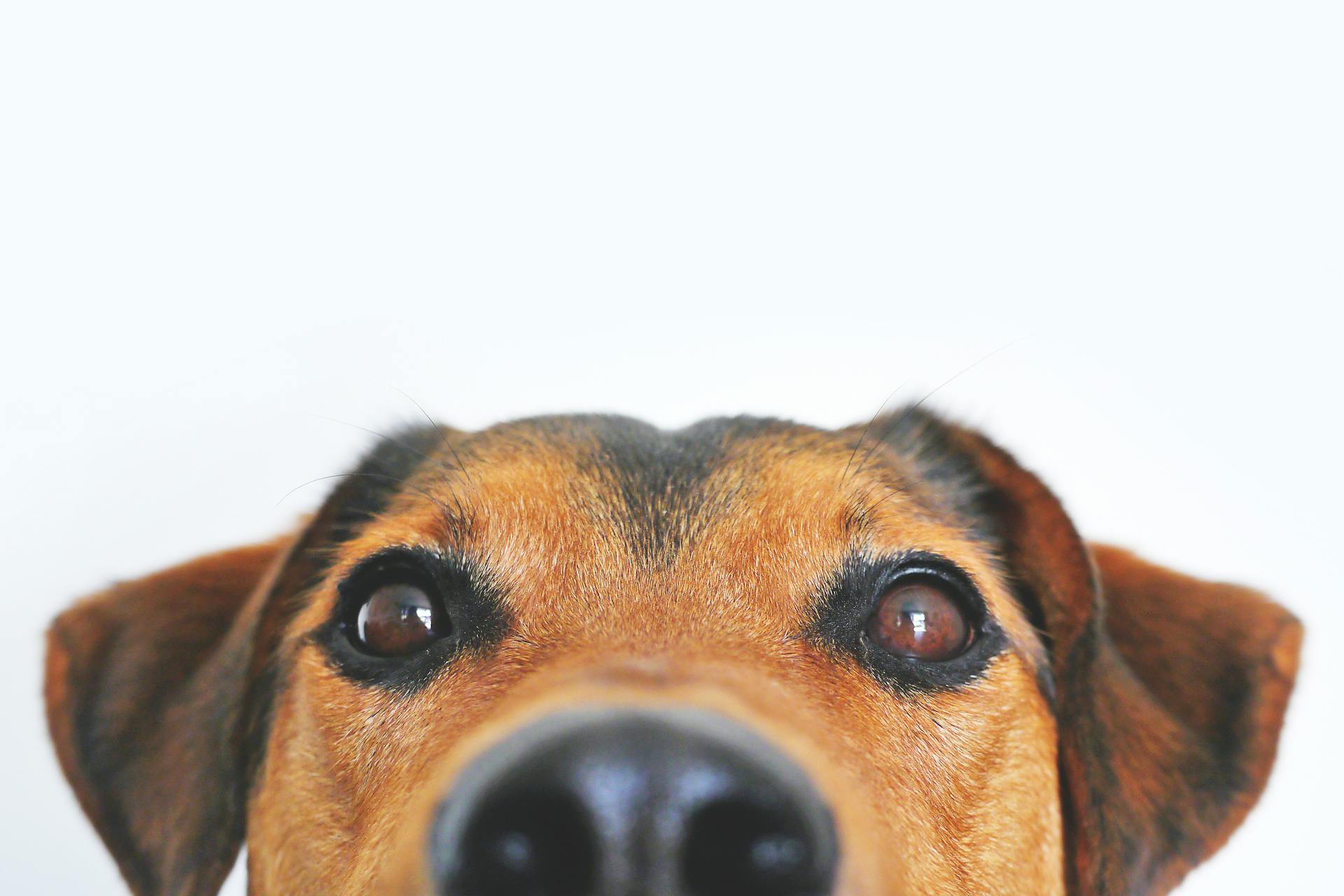
Lip-fold pyoderma is another skin infection that affects Bloodhounds, causing a reddened, smelly area in the folds of skin along the lower jaw. If left untreated, it can become severe and require surgical removal of excess skin folds.
Regular brushing of your Bloodhound's coat can help prevent skin problems by reducing the amount of loose hair and dirt that can get trapped in the skin folds. This simple habit can make a big difference in your dog's overall health and comfort.
Nutrition and Feeding
Bloodhounds do well on a large-breed diet that's appropriate for their current life stage, so it's best to discuss this with your veterinarian.
Feeding your Bloodhound multiple smaller meals, such as two or three times a day, can help prevent bloat and GDV, a serious health issue for deep-chested dogs like Bloodhounds.
Adult Bloodhounds typically eat between 4-8 cups of dry food per day, depending on their weight and level of daily activity.
Obesity is a significant health problem in Bloodhounds, leading to joint problems, metabolic and digestive disorders, back pain, and heart disease, so it's essential to monitor their diet and exercise regularly.
To keep your Bloodhound happy and healthy, watch their diet, ensure they get plenty of exercise, and regularly brush their teeth and coat.
Obesity
Obesity can be a significant health problem in dogs. It's a serious disease that may cause or worsen joint problems, metabolic and digestive disorders, back pain, and heart disease.
Giving your dog leftover people food and doggie treats can lead to obesity. This can "love her to death" with excessive calories.
You can show your dog love and affection without overfeeding her. A simple hug, a brush of her fur or teeth, or a game of playtime can make her feel better.
Taking your dog for a walk is a great way to exercise her and help her maintain a healthy weight. It's a win-win for both you and your dog.
If this caught your attention, see: Lyme Vaccination for Dogs Side Effects
Feeding a Dog
Feeding a dog requires attention to their individual needs and health status. Discussing the best diet with your veterinarian is essential, especially if your pup has specific medical history.
Bloodhounds do well on a large-breed diet, but it's crucial to choose high-quality ingredients. This may involve selecting a specific food that suits your dog's life stage.
Feeding multiple smaller meals throughout the day can help prevent GDV or bloat in deep-chested dogs like Bloodhounds. This can be achieved by dividing their daily ration into two or three meals.
The amount of daily food required for adult Bloodhounds varies, but a general guideline is to feed between 4-8 cups of dry food per day. This amount may need to be adjusted based on your dog's weight and level of activity.
Obesity is a significant health problem in Bloodhounds, which can lead to joint issues, metabolic disorders, and heart disease. Avoid giving your dog leftover people food and dog treats, as this can exacerbate the problem.
For more insights, see: Dog Problem Training
Regular feeding and exercise schedules can help maintain your dog's weight and overall health. Brushing their teeth and coat regularly can also contribute to their well-being.
Signing up for pet health insurance is a crucial step in covering medical costs associated with feeding and caring for your dog. This can provide peace of mind and ensure your dog receives the necessary care throughout their life.
Care and Wellness
Taking care of your Bloodhound's health is crucial to ensure they live a long and happy life. Regular veterinary check-ups and vaccinations are essential to prevent diseases and conditions common in Bloodhounds.
To keep your Bloodhound's diet on track, feed them multiple smaller meals throughout the day, avoid elevated food bowls, and limit vigorous exercise around mealtimes to prevent GDV or bloat.
Brushing your Bloodhound's teeth daily will prevent periodontal disease, which is a common issue in this breed. Regular ear cleaning, especially for puppies, is also crucial to prevent infections.
Related reading: Common Problems with Chihuahuas
You should supervise your Bloodhound like you would a toddler, keeping doors closed and picking up after yourself to prevent them from getting into trouble. Regular exercise and mental stimulation are also vital to keep your Bloodhound happy and healthy.
Here's a summary of the essential routine care for your Bloodhound:
- Supervise your pet as you would a toddler
- Brush their coat as needed, at least weekly
- Brush their teeth at least twice a week
- Clean their ears weekly
- Keep their diet consistent and avoid people food
- Exercise them regularly, but don't overdo it at first
Regularly checking your Bloodhound's facial wrinkles and eyes can also help prevent debris buildup and other issues.
Health Emergencies
If you notice any of the following signs in your Bloodhound, seek medical care immediately.
Scratching or shaking the head, tender ears, or ear discharge can indicate a serious ear infection. Inability or straining to urinate, discolored urine, and cloudiness, redness, itching, or any other abnormality involving the eyes are all symptoms of potential health issues.
A dry heaving or a large, tight, painful abdomen can be a sign of Gastric Dilatation and Volvulus (Bloat), a life-threatening condition that requires immediate veterinary attention. Other potential emergency symptoms include general reluctance to run or play, swollen lymph nodes or glands, unexplained weight loss, dragging the hind toes and hind limb weakness, any abnormal shaking, trembling, or excessive involuntary tremors, tiring easily, coughing, a swollen belly or fainting/collapse, and dull coat, hair loss, sluggish, weight gain.
A fresh viewpoint: Dog Keeps Shaking Head after Grooming
Here is a list of emergency symptoms to watch out for:
- Scratching or shaking the head, tender ears, or ear discharge
- Inability or straining to urinate; discolored urine
- Cloudiness, redness, itching, or any other abnormality involving the eyes
- Dry heaving or a large, tight, painful abdomen
- General reluctance to run or play
- Swollen lymph nodes or glands, unexplained weight loss
- Dragging the hind toes and hind limb weakness
- Any abnormal shaking, trembling, or excessive involuntary tremors
- Tiring easily, coughing, a swollen belly or fainting/collapse
- Dull coat, hair loss, sluggish, weight gain
Emergencies
If you notice any of these signs in your dog, seek medical care immediately.
Scratching or shaking the head, tender ears, or ear discharge can be a sign of an ear infection.
Inability or straining to urinate; discolored urine can be a sign of a urinary tract infection.
Cloudiness, redness, itching, or any other abnormality involving the eyes can be a sign of an eye infection.
Dry heaving or a large, tight, painful abdomen can be a sign of gastric dilatation and volvulus, also known as bloat.
Here are some other signs that require immediate veterinary attention:
- General reluctance to run or play
- Swollen lymph nodes or glands, unexplained weight loss
- Dragging the hind toes and hind limb weakness
- Any abnormal shaking, trembling, or excessive involuntary tremors
- Tiring easily, coughing, a swollen belly or fainting/collapse
- Dull coat, hair loss, sluggish, weight gain
If you notice any of these signs in your dog, don't hesitate to call your vet and get your dog to the clinic as fast as possible. Bloat, in particular, is a life-threatening emergency that requires immediate attention.
What to Watch
As a Bloodhound owner, it's essential to be aware of potential health issues that can arise. Many diseases and health conditions are genetic, meaning they're related to your pet's breed. Brushing your dog's teeth daily will prevent periodontal disease.
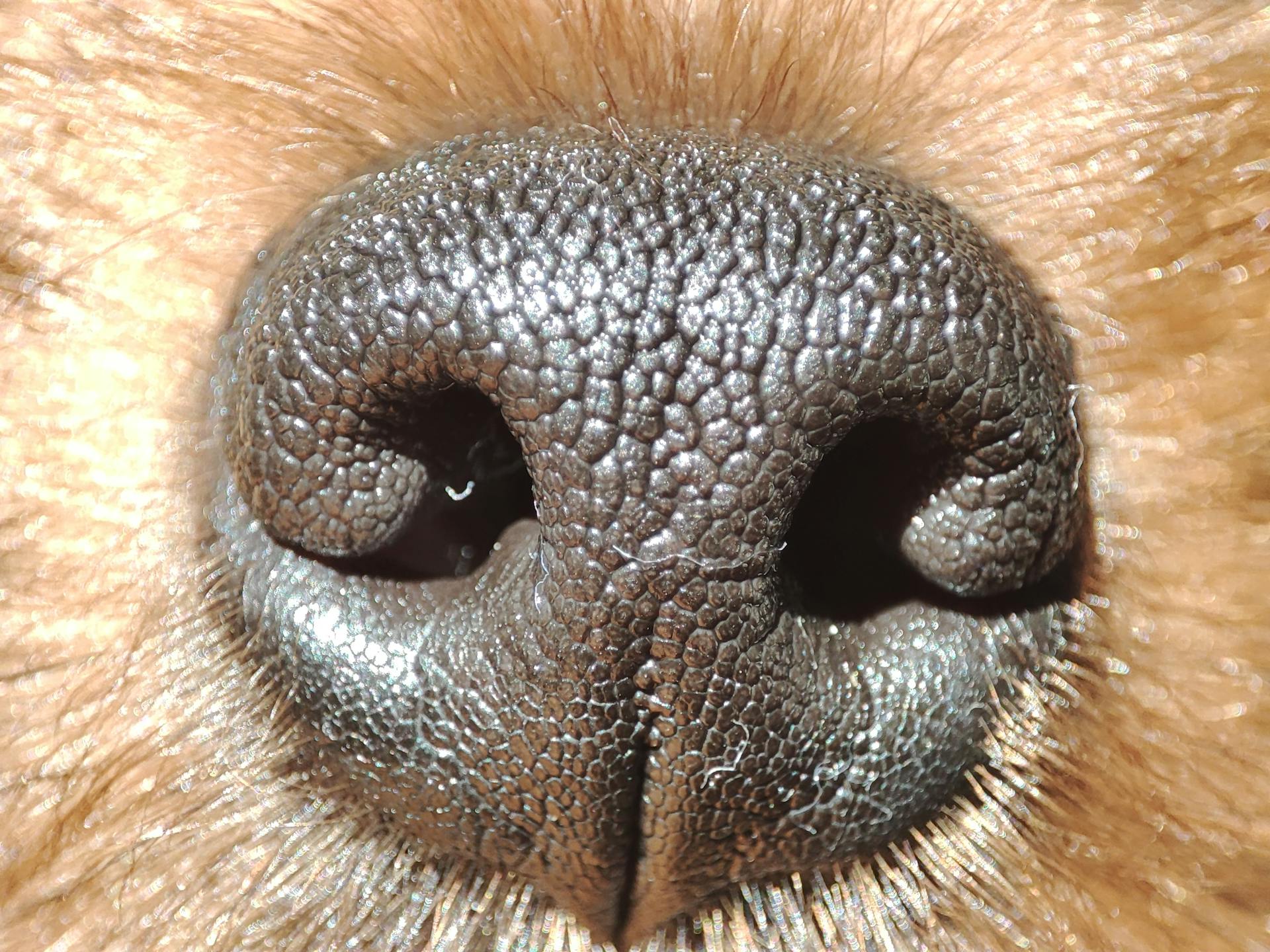
Gastric Dilatation and Volvulus is a serious condition that can be life-threatening if not treated promptly. Prolapse of the third eyelid gland, also known as cherry eye, can be painful and requires veterinary attention.
Keep an eye out for any abnormal symptoms, as they could be a sign of serious disease. Change in appetite or water consumption, tartar build-up, bad breath, red gums, or broken teeth are all potential indicators of a health issue.
Itchy skin, hair loss, lethargy, mental dullness, or excessive sleeping can also be symptoms of a underlying problem. Fearfulness, aggression, or other behavioral changes can be a sign that your Bloodhound needs help.
Here are some key symptoms to watch for:
- Change in appetite or water consumption
- Tartar build-up, bad breath, red gums, or broken teeth
- Itchy skin (scratching, chewing or licking), hair loss
- Lethargy, mental dullness, or excessive sleeping
- Fearfulness, aggression, or other behavioral changes
Spaying or Neutering
Spaying or neutering your Bloodhound is one of the best things you can do for their health.
This surgery decreases the likelihood of certain types of cancers.
Spaying or neutering also eliminates the possibility of your pet becoming pregnant or fathering unwanted puppies.
Performing this surgery gives us a chance to identify and address some diseases your dog is likely to develop, such as hip problems or dental issues.
Routine blood testing prior to surgery helps us identify and take precautions for common problems that increase anesthetic or surgical risk.
Here's an interesting read: Female Dog Hormone Imbalance after Spaying
Coat and General Care
Bloodhounds have a short, dense coat that requires regular brushing to reduce shedding. Brushing their coat at least weekly is a good rule of thumb.
You should also be aware that Bloodhounds are moderate shedders and may require more frequent brushing during shedding season, which occurs twice a year.
To keep their coat looking its best, it's only necessary to bathe them every few months, unless they get especially smelly.
Suggestion: Why Is My Female Dog Shedding so Much
Health Topics
Brushing your dog's teeth daily is a simple yet effective way to prevent periodontal disease, which can lead to more serious health issues.
Bloodhounds are prone to certain health conditions due to their breed, and it's essential to be aware of these potential issues to provide the best care for your pet.
Many diseases and health conditions in Bloodhounds are genetic, so it's crucial to work with your veterinarian to develop a preventive health plan tailored to your dog's needs.
Gastric Dilatation and Volvulus is a condition that can affect Bloodhounds, and it's essential to be aware of the signs and symptoms to seek veterinary care promptly.
Prolapse of the third eyelid gland, also known as cherry eye, is another common issue in Bloodhounds, and regular check-ups with your veterinarian can help catch it early.
Bloodhounds have an average lifespan of 10-12 years, and responsible breeders should screen for health conditions that commonly affect the breed.
Sources
- https://canadasguidetodogs.com/bloodhound/bloodhound-health-issues/
- https://companioncarevethospital.com/client-resources/breed-info/bloodhound/
- https://companionpetvet.com/client-resources/breed-info/bloodhound/
- https://www.animalhealthcenternjwc.com/client-resources/breed-info/bloodhound/
- https://www.petmd.com/dog/breeds/bloodhound
Featured Images: pexels.com
